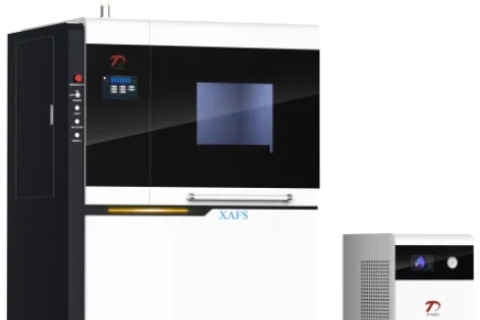
- Home
- >
News
Dandong Tongda XAFS Spectrometer: A Material Structure Analysis Tool for the Laboratory Precise analysis of atomic material structure without dependence on synchrotron radiation sources. X-ray Absorption Fine Structure (XAFS) spectroscopy serves as an important technique for investigating the local atomic and electronic structures of materials, with broad applications in catalysis, energy research, and materials science. Conventional XAFS methodology primarily relies on synchrotron radiation sources, which presents challenges including limited beam availability, complex application procedures, and the necessity to transport samples to large-scale scientific facilities for analysis. The X-ray Absorption Fine Structure developed by Dandong Tongda Technology Co., Ltd. aims to integrate this sophisticated analytical capability into standard laboratory environments. Core Advantages and Practical Value This instrument's design addresses several critical challenges researchers encounter: Laboratory-Based Alternative to Synchrotron Radiation: Eliminates the traditional dependency on synchrotron radiation sources, enabling researchers to conduct routine XAFS testing efficiently within their own laboratory settings, thereby significantly enhancing research productivity. In-Situ Testing Capabilities: Supports integration of various in-situ sample chambers (e.g., electrochemical, temperature-variable), enabling real-time monitoring of dynamic changes in material local atomic structure under simulated operational conditions (such as catalytic reactions or battery charge/discharge processes), providing valuable insights into reaction mechanisms. Automated Operation for Enhanced Efficiency: An 18-position sample turret enables automatic sample changing, facilitating continuous automated measurement of multiple samples and unmanned operation, thereby streamlining batch sample screening and extended in-situ experiments. Broad Application Scope The TD-XAFS spectrometer finds applications across numerous fields requiring detailed investigation of material local structures: New Energy Materials: Analysis of valence state changes and structural stability in lithium-ion battery electrode materials during charge/discharge processes; investigation of coordination environments at catalytic active sites in fuel cells. Catalysis Science: Particularly suitable for studying precise coordination structures of nanocatalysts and single-atom catalysts, active site characteristics, and their interactions with support materials, even at low metal loadings (<1%). Materials Science: Investigation of disordered structures, amorphous materials, surface/interface effects, and dynamic phase transition processes. Environmental Science: Analysis of valence states and coordination structures of heavy metal elements in environmental samples (e.g., soil, water), crucial for assessing toxicity and mobility. Biological Macromolecules: Study of electronic structures and geometric configurations of metal active centers in metalloproteins and enzymes. Summary Dandong Tongda's TD-XAFS spectrometer represents a high-performance domestic benchtop testing platform designed for universities, research institutions, and corporate R&D centers. It successfully incorporates synchrotron-level capabilities into conventional laboratories, substantially reducing the accessibility barrier to XAFS technology. The instrument provides researchers with convenient, efficient, and flexible tools for microscopic material structure analysis, serving as a practical solution for scientists exploring the microscopic world of matter.
X-ray absorption fine structure spectrometer (XAFS) is a powerful tool for studying the local atomic or electronic structure of materials, widely used in popular fields such as catalysis, energy, and nanotechnology. The basic principle of X-ray absorption fine structure spectrometer (XAFS) is that when the energy of X-rays resonates with the energy of an inner electron shell of an element in the sample, a sudden increase in electrons is excited to form a continuous spectrum, which is called the absorption edge. Near the absorption edge, as the X-ray energy increases, the absorption rate monotonically decreases as the penetration depth of the X-ray increases. When the spectrum is extended beyond a specific edge, fine structures can be observed, where X-ray absorption near edge structures (XANES) regions appear as soon as peaks and shoulders with a width exceeding 20 to 30 electron volts pass through the starting point of the edge. The fine structure located on the high-energy side of the edge where energy decays to several hundred electron volts is called X-ray Absorption Fine Structure (XAFS). The main features of X-ray absorption fine structure spectrometer (XAFS) are: Sensitivity to short-range ordering: It depends on short-range ordering and does not rely on long-range ordering, making it possible to measure a wide range of samples. It can be used for amorphous, liquid, molten, catalyst active centers, metal proteins, etc., as well as for structural studies of impurity atoms in crystals. Strong elemental characteristics: The X-ray absorption edge has elemental characteristics, and for atoms of different elements in the sample, the atomic neighbor structure of different elements in the same compound can be studied by adjusting the incident X-ray energy. High sensitivity: Fluorescence method can be used to measure samples of elements with concentrations as low as one millionth. Comprehensive acquisition of structural information: able to provide parameters that determine the local structure, such as the distance between absorbing atoms and neighboring atoms, the number and type of these atoms, and the oxidation state of absorbing elements. Sample preparation is simple: no single crystal is required, and under the experimental conditions, the data collection time is relatively short. Using a synchrotron X-ray source usually only takes a few minutes to measure a spectral line. The main advantages of X-ray absorption fine structure spectrometer (XAFS) are: Core advantage: highest luminous flux product Photon flux exceeding 1000000 photons/second/eV, with spectral efficiency several times higher than other products; Obtain data quality equivalent to synchrotron radiation Excellent stability: The stability of monochromatic light intensity of the light source is better than 0.1%, and the energy drift during repeated collection is less than 50 meV 1% detection limit: High luminous flux, excellent optical path optimization, and excellent light source stability ensure that high-quality EXAFS data can still be obtained when the measured element content is>1%. 4. Application areas of X-ray absorption fine structure spectrometer (XAFS) : Energy field: such as research on lithium batteries and other secondary battery materials, fuel cell research, hydrogen storage material research, etc. XAFS can be used to obtain the concentration, valence state, coordination environment, and dynamic changes of core atoms during charge discharge cycles and electrochemical reactions. Catalysis field: used for research on nanoparticle catalysis, single atom catalysis, etc. Obtain the morphology of the catalyst on the support, the interaction form with the support, and its changes during the catalytic process through XAFS, as well as the neighboring structures of metal ions with extremely low content. In the field of materials science, X-ray absorption fine structure spectrometer (XAFS) is used for the characterization of various materials, the study of complex systems and disordered structural materials, the research of radioactive isotopes, the study of related properties of surface and interface materials, and the study of dynamic changes in materials. In the field of geology, X-ray absorption fine structure spectrometer (XAFS) can be used for element valence state analysis of ore materials in geological research. Environmental field: XES can be used for valence state analysis of Cr/As elements, etc. In the field of radiochemistry, X-ray absorption fine structure spectrometer (XAFS) can be used for valence state analysis of Ce, U elements, etc. The X-ray absorption fine structure spectrometer (XAFS) plays an important role in modern scientific research due to its unique working principle, significant characteristics, and wide application fields. It provides a powerful means for people to gain a deeper understanding of the microstructure and chemical state of matter, promoting the development and progress of multiple disciplinary fields.
X-ray absorption fine structure Spectrum (XAFS) is a powerful tool for studying the local atomic or electronic structure of materials, widely used in popular fields such as catalysis, energy, and nanotechnology. The principle of X-ray absorption fine structure Spectrum(XAFS): X-ray absorption fine structure Spectrum refers to high-resolution spectra near the characteristic edges of atomic core electrons absorbing X-rays. When the energy of X-rays is the same as the excitation energy of the inner shell electrons of the measured element, they will be strongly absorbed, resulting in an absorption limit (or absorption edge). Near the absorption edge, due to multiple scattering and other reasons, the absorption coefficient of X-rays will exhibit oscillatory phenomena, namely fine structure. 2. Core advantages of X-ray absorption fine structure Spectrum(XAFS): (1) The highest luminous flux product, with a photon flux exceeding 1000000 photons/second/eV, and a spectral efficiency several times higher than other products; Obtain data quality equivalent to synchrotron radiation (2) Excellent stability, monochromatic light intensity stability of the light source is better than 0.1%, and repeated energy drift is less than 50 meV (3) 1% detection limit, high light flux, excellent optical path optimization, and excellent light source stability ensure that high-quality EXAFS data can still be obtained when the measured element content is>1%. 3. Application areas of XAFS: Industrial catalysis, energy storage materials, nanomaterials, environmental toxicology, qualitative analysis, heavy element analysis, etc. 4. Main features of XAFS: (1) Short range ordering: EXAFS depends on short-range interactions and does not rely on long-range ordering. XAFS can be used to study the structure of disordered systems such as amorphous, liquid, molten, and catalyst active centers. (2) Element specificity: Fluorescence method can be used to measure samples of elements with concentrations as low as one millionth. By adjusting the incident X-ray energy, the neighboring structures of atoms of different elements in the same compound can be studied. (3) Polarization characteristics: Polarized X-rays can be used to measure atomic bond angles and surface structures in oriented samples. The X-ray absorption fine structure Spectrum, with its unique principles, significant characteristics, and wide application fields, has become an indispensable and important tool in multiple fields such as materials science, catalytic chemistry, and energy research, providing strong support for in-depth exploration of material microstructures and electronic states.
X-ray absorption fine structure spectrometer (XAFS) is a powerful tool for studying the local atomic or electronic structure of materials, widely used in popular fields such as catalysis, energy, and nanotechnology.
X-ray absorption fine structure spectrum (XAFS) is an analytical tool used to study the structure and properties of substances. XAFS obtains information about atoms and molecules in a sample by measuring the X-ray absorption of the sample within a specific energy range. XAFS is a powerful tool for studying the local atomic or electronic structure of materials.XAFS technology is widely used in materials science, chemistry, biology, and other fields, especially in research areas such as catalysis, batteries, sensors, etc. XAFS has important application value. Through XAFS technology, researchers can gain a deeper understanding of the microstructure and properties of samples, providing powerful support for the design and optimization of new materials.
X-ray absorption fine structure spectrometer is a powerful tool for studying the local atomic or electronic structure of materials, widely used in popular fields such as catalysis, energy, and nanotechnology. XAFS core advantages: Highest luminous flux product: Photon flux exceeding 1000000 photons/second/eV, with spectral efficiency several times higher than other products; Obtain data quality equivalent to synchrotron radiation Excellent stability: The stability of monochromatic light intensity of the light source is better than 0.1%, and the energy drift during repeated collection is less than 50 meV 1% detection limit: High luminous flux, excellent optical path optimization, and excellent light source stability ensure high-quality EXAFS data is obtained even when the measured element content is>1%。
Using X-ray diffraction (transmission) method to test the unique crystal structure of fibers. Test the orientation of the sample based on data such as fiber texture and half peak width.
The data collected through low-temperature equipment yields more ideal results. With the help of low-temperature equipment, more advantageous conditions can be provided, which can enable undesirable crystals to obtain ideal results, as well as ideal crystals to obtain more ideal results.
θ - θ structure, the sample remains stationary while the radiation source and detector rotate; Adopting imported high-precision bearing transmission, with good stability; High precision fully closed-loop vector drive servo system control, Contains 32-bit RISC microprocessor and high-resolution magnetic encoder for automatic error correction;
The crystal structure of the perovskite films modified by ionic liquid (ILs) BMIMAc under various annealing durations was characterized by X-ray diffraction.
Battery material analysis helps to understand and optimize battery performance, improve battery safety and life, reduce costs, and promote the development and application of new materials.












